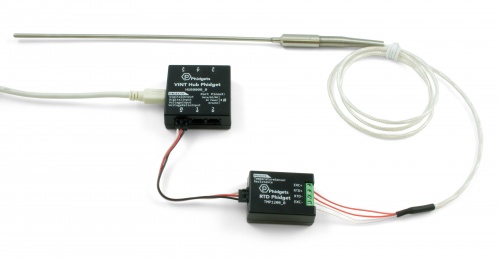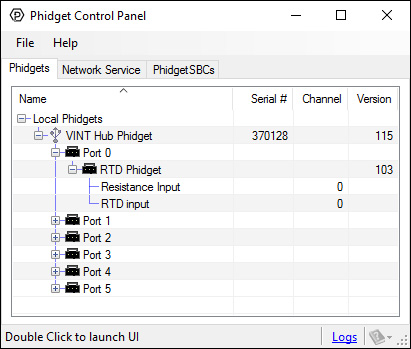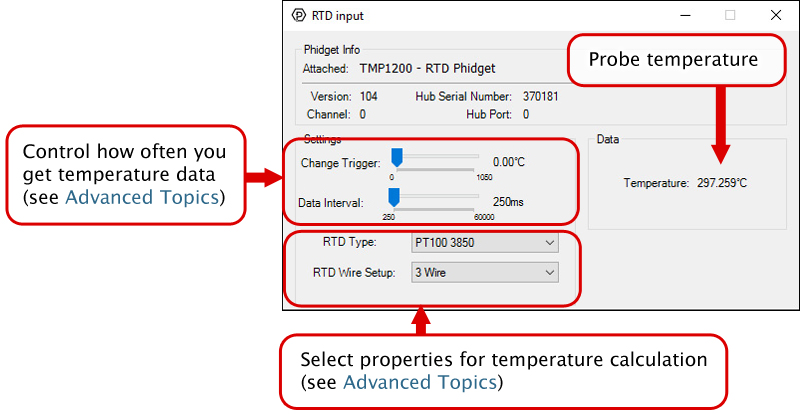TMP1200 User Guide: Difference between revisions
No edit summary |
No edit summary |
||
| Line 1: | Line 1: | ||
__NOINDEX__ | __NOINDEX__ | ||
__NOTOC__ | |||
<metadesc>Measure RTDs, thermistors, and other resistance-based sensors with the RTD Phidget. Connects to a port on your VINT Hub.</metadesc> | <metadesc>Measure RTDs, thermistors, and other resistance-based sensors with the RTD Phidget. Connects to a port on your VINT Hub.</metadesc> | ||
[[Category:UserGuide]] | [[Category:UserGuide]] | ||
== | ==Part 1: Setup== | ||
{{UGIntro|TMP1200}} | {{UGIntro|TMP1200}} | ||
| Line 19: | Line 20: | ||
<br clear="all"> | <br clear="all"> | ||
{{UGcontrolpanel|TMP1200}} | |||
== Part 2: Using Your Phidget == | |||
===About=== | |||
The TMP1200 allows you to precisely measure temperature using RTDs, thermistors, and other resistance-based sensors. Measure temperature from your RTD in degrees Celsius by selecting the RTD type and the number of wires in the software. You can also read thermistors and other resistive sensors by using the resistance sensor object in your program. You'll receive the data in ohms and can convert to the desired unit by using the formula in your sensor's datasheet. You could even use it as a simple ohmmeter for resistances up to 19 kΩ. | |||
===Explore Your Phidget Channels Using The Control Panel=== | |||
You can use your Control Panel to explore your Phidget's channels. | |||
'''1.''' Open your Control Panel, and you will find the following channels: | |||
[[Image:TMP1200_Panel.jpg|link=|center]] | |||
'''2.''' Double click on a channel to open an example program. Each channel belongs to a different channel class: | |||
{{UGC-Start}} | |||
{{UGC-Entry|Resistance Input:| Measures the raw resistance of the RTD probe| | |||
In your Control Panel, double click on "Resistance Input": | |||
[[Image:TMP1200-ResistanceInput.jpg|center|link=]]}} | |||
{{UGC-Entry|RTD Input:| Reports the temperature of the RTD probe| | |||
In your Control Panel, double click on "RTD Input": | |||
[[Image:TMP1200-TemperatureSensor.jpg|center|link=]]}} | |||
{{UGC-End}} | |||
{{UG-Part3}} | |||
== Part 4: Advanced Topics and Troubleshooting == | |||
{{UGC-Start}} | |||
{{UGC-Addressing}} | |||
{{UGC-DataInterval}} | |||
{{UGC-Entry|Wiring Instructions|| | |||
===Two-Wire Mode=== | |||
This is the simplest wiring setup for an RTD, but also the least accurate because the resistance of the leads are not taken into account. To connect a 2-wire RTD to the RTD Phidget, connect one wire to the RTD+ terminal, and the other to the RTD- terminal. Then connect the EXC+ terminal to the RTD+ terminal and the EXC- to the RTD- terminal with two short wires. | |||
In your program, set {{Code|RTDWireSetup}} to 2-wire mode. In the {{Phidget22 API}} select the TMP1200 and your programming language of choice to see exact naming conventions. | |||
===Three-Wire Mode=== | |||
In a three-wire RTD, the extra wire is added to measure the resistance of one of the leads. This calculation assumes that both leads have the same resistance. Your RTD should have two wires that share a color; connect one of these wires to the RTD- terminal and the other to the EXC- terminal. The differently colored wire connects to the RTD+ terminal. Then connect the EXC+ terminal to the RTD+ terminal with a short wire. | |||
In your program, set {{Code|RTDWireSetup}} to | In your program, set {{Code|RTDWireSetup}} to 3-wire mode. In the {{Phidget22 API}} select the TMP1200 and your programming language of choice to see exact naming conventions. | ||
=== | ===Four-Wire Mode=== | ||
A four-wire RTD is normally used in precision measurement, when the assumption that both leads have the same resistance is not accurate enough. Unfortunately the RTD Phidget does not support this particular feature of four-wire RTDs. It does support the use of four-wire RTDs using the same assumption as three-wire mode. To connect a four-wire RTD, simply connect one pair of same-colored wires to the RTD+ and EXC+ terminals, and the other pair to the RTD- and EXC- terminals. | |||
In your program, set {{Code|RTDWireSetup}} to 4-wire mode. In the {{Phidget22 API}} select the TMP1200 and your programming language of choice to see exact naming conventions. | |||
}} | |||
{{UGC-Entry|Line Resistance Measurement|| | |||
In three and four wire modes, this device will measure the line resistance every 5 minutes. This measurement will cause a delay in measurement for data intervals of less than 500ms. To force the line resistance to be recalculated, you must close and re-open the device. | |||
}} | |||
{{ | {{UGC-End}} | ||
Revision as of 21:40, 4 August 2020
Part 1: Setup
Welcome to the TMP1200 user guide! In order to get started, make sure you have the following hardware on hand:
- TMP1200 RTD Phidget
- VINT Hub
- Phidget cable
- USB cable and computer
- platinum RTD
Next, you will need to connect the pieces:

- Connect the TMP1200 to the VINT Hub using the Phidget cable.
- Connect the RTD to the Phidget. See the technical section for more information.
- Connect the VINT Hub to your computer with a USB cable.
Phidget Control Panel
In order to demonstrate the functionality of the TMP1200, the Phidget Control Panel running on a Windows machine will be used.
The Phidget Control Panel is available for use on both macOS and Windows machines.
Windows
To open the Phidget Control Panel on Windows, find the ![]() icon in the taskbar. If it is not there, open up the start menu and search for Phidget Control Panel
icon in the taskbar. If it is not there, open up the start menu and search for Phidget Control Panel
macOS
To open the Phidget Control Panel on macOS, open Finder and navigate to the Phidget Control Panel in the Applications list. Double click on the ![]() icon to bring up the Phidget Control Panel.
icon to bring up the Phidget Control Panel.
For more information, take a look at the getting started guide for your operating system:
Linux users can follow the getting started with Linux guide and continue reading here for more information about the TMP1200.
First Look
After plugging the TMP1200 into your computer and opening the Phidget Control Panel, you will see something like this:

The Phidget Control Panel will list all connected Phidgets and associated objects, as well as the following information:
- Serial number: allows you to differentiate between similar Phidgets.
- Channel: allows you to differentiate between similar objects on a Phidget.
- Version number: corresponds to the firmware version your Phidget is running. If your Phidget is listed in red, your firmware is out of date. Update the firmware by double-clicking the entry.
The Phidget Control Panel can also be used to test your device. Double-clicking on an object will open an example.
Part 2: Using Your Phidget
About
The TMP1200 allows you to precisely measure temperature using RTDs, thermistors, and other resistance-based sensors. Measure temperature from your RTD in degrees Celsius by selecting the RTD type and the number of wires in the software. You can also read thermistors and other resistive sensors by using the resistance sensor object in your program. You'll receive the data in ohms and can convert to the desired unit by using the formula in your sensor's datasheet. You could even use it as a simple ohmmeter for resistances up to 19 kΩ.
Explore Your Phidget Channels Using The Control Panel
You can use your Control Panel to explore your Phidget's channels.
1. Open your Control Panel, and you will find the following channels:

2. Double click on a channel to open an example program. Each channel belongs to a different channel class:
In your Control Panel, double click on "Resistance Input":

In your Control Panel, double click on "RTD Input":

Part 3: Create your Program
1. Setting up your Programming Environment
Part 4: Advanced Topics and Troubleshooting
Before you open a Phidget channel in your program, you can set these properties to specify which channel to open. You can find this information through the Control Panel.
1. Open the Control Panel and double-click on the red map pin icon:

2. The Addressing Information window will open. Here you will find all the information you need to address your Phidget in your program.

See the Phidget22 API for your language to determine exact syntax for each property.
The Change Trigger is the minimum change in the sensor data needed to trigger a new data event.
The Data Interval is the time (in ms) between data events sent out from your Phidget.
The Data Rate is the reciprocal of Data Interval (measured in Hz), and setting it will set the reciprocal value for Data Interval and vice-versa.
You can modify one or both of these values to achieve different data outputs. You can learn more about these properties here.
Two-Wire Mode
This is the simplest wiring setup for an RTD, but also the least accurate because the resistance of the leads are not taken into account. To connect a 2-wire RTD to the RTD Phidget, connect one wire to the RTD+ terminal, and the other to the RTD- terminal. Then connect the EXC+ terminal to the RTD+ terminal and the EXC- to the RTD- terminal with two short wires.
In your program, set RTDWireSetup to 2-wire mode. In the Phidget22 API select the TMP1200 and your programming language of choice to see exact naming conventions.
Three-Wire Mode
In a three-wire RTD, the extra wire is added to measure the resistance of one of the leads. This calculation assumes that both leads have the same resistance. Your RTD should have two wires that share a color; connect one of these wires to the RTD- terminal and the other to the EXC- terminal. The differently colored wire connects to the RTD+ terminal. Then connect the EXC+ terminal to the RTD+ terminal with a short wire.
In your program, set RTDWireSetup to 3-wire mode. In the Phidget22 API select the TMP1200 and your programming language of choice to see exact naming conventions.
Four-Wire Mode
A four-wire RTD is normally used in precision measurement, when the assumption that both leads have the same resistance is not accurate enough. Unfortunately the RTD Phidget does not support this particular feature of four-wire RTDs. It does support the use of four-wire RTDs using the same assumption as three-wire mode. To connect a four-wire RTD, simply connect one pair of same-colored wires to the RTD+ and EXC+ terminals, and the other pair to the RTD- and EXC- terminals.
In your program, set RTDWireSetup to 4-wire mode. In the Phidget22 API select the TMP1200 and your programming language of choice to see exact naming conventions.
In three and four wire modes, this device will measure the line resistance every 5 minutes. This measurement will cause a delay in measurement for data intervals of less than 500ms. To force the line resistance to be recalculated, you must close and re-open the device.
